Biodiversity during Pre and Post Hula Valley (Israel) Drainage
Abstract
1. Introduction
2. Background
2.1. Geology and Hydrology
2.2. Hula Drainage
3. Material and Methods
- Kinneret Limnological Laboratory, IOLR, (LKDB): Information about Lake Kinneret [2].
- Lake Kinneret and its Drainage Basin Authority [5]: Information about anthropogenic activity in the Hula Valley.Books:
- Lake Kinneret, Monographiae Biologicae Vol 32 [6];Lake Kinneret, Chapter 1, The Lake [7];
- Different Kinneret [8];
- Agriculture, Recreation, Water Quality and Nature Protection in the Hula Valley, Israel. 70 years of a Mega-ecological Project, Springer Geography [9];
- The Role of Red Lines” in Safeguarding the Sea of Galilee (Lake Kinneret) [10];
- Israel Water Resources, Chapter on Hydrology and Environmental Sciences, Yad Ben-Zvi Press, Jerusalem [11];
- Lake Hula. Israeli Academy of Sciences and Humanities, Jerusalem [12]
- Hula Project Monitoring Summarized Report, Long-Term Analysis, National Water Authority, Jewish National Fund (KKL), Farmers of the Peat Soil Convention; Project No. 4501334109, ref. [13]
4. Results
4.1. Regional Hydrology
- Total Gain—655
- Inflows—630
- Rainfall—25
- Total Loss—655
- Outflows—595
- Lake
- Evaporation—25
- Swamps
- Evapotranspiration—35
4.2. Underground Water Table after Drainage
4.3. Ecotourism Development
4.4. Species Richness
4.5. Vascular Plant Species Richness
4.6. Unwanted Plant Species (Included in Grand Total Name List)
4.7. Fish Species Richness
4.8. Amphibian Species Richness
4.9. Mammalian Rodent Species Richness
4.10. Reptilian Species Richness
4.11. Mammalian Species Richness
5. Discussion
6. Epilogue
Funding
Institutional Review Board Statement
Informed Consent Statement
Data Availability Statement
Acknowledgments
Conflicts of Interest
References
- Gophen, M.; Meron, M.; Levin-Orlov, V.; Tsipris, Y.; Peres, M. Climate Change, Regional Water Balance and Land Use Policy, in the Watershed of Lake Kinneret (Israel). Open J. Ecol. 2020, 10, 200–224. [Google Scholar] [CrossRef]
- LKDB-1969-2021; Haifa Data Base, Water Level Record in Annual Report 1969–2021. Kinneret Limnological Laboratory, IOLR Co. Ltd.: Migdal, Israel, 2021. (In Hebrew)
- Mekorot, National Water Company. 1986–2018, Interim Report Water, Salt, and Energy Balances for Lake Kinneret, 2019/20; Mekorot: Tel Aviv, Israel, 2020; 41p. (In Hebrew) [Google Scholar]
- Hydrological Service. Hydrological Status, Surface Water, and Ground Water Table in Monthly Reports; National Water Authority, Department of Surface Water, Hydrology, Hydrometeorology, Hydrometry, Conservation of Northern Water Resources: Tel-Aviv, Israel, 2022. (In Hebrew) [Google Scholar]
- TAHAL. Water Planning in Israel (1960–1988); Monitoring and Salt and Water Balances Evaluation in Lake Kinneret; Annual Reports; TAHAL: Tel-Aviv, Israel, 1988. (In Hebrew) [Google Scholar]
- Serruya, C. Lake Kinneret Monographiae Biologicae; Dr. W. Junk Publishers: The Hague, The Netherlands, 1978; Volume 32, 501p. [Google Scholar]
- Gophen, M. Chapter, Part 1: The Lake in: Lake Kinneret; Ministry of Defense—Israel and Kinneret Authority: Tel Aviv, Israel, 1992; 159p, ISBN 965-05-0623-3. [Google Scholar]
- Gophen, M. Different Kinneret; MIGAL: Qiryat Shmona, Israel, 2019; 158p, ISBN 978-965-92758-2-3. (In Hebrew) [Google Scholar]
- Gophen, M. Agriculture, Recreation, Water Quality and-Nature-Protection-in the-Hula-Valley, Israel: 70 Years-of-a-Mega-Ecological-Project; Springer: Berlin/Heidelberg, Germany, 2023; 243p, ISBN 978-3-031-23411-8. [Google Scholar]
- Feitelson, E.; Gazit, T.; Fischhendler, I. The Role of “Red Lines” in Safeguarding the Sea of Galilee (Lake Kinneret); The Jerusalem Institute for Israeli Studies: Jerusalem, Israel, 2005; 75p, (In Hebrew; English Abstract). [Google Scholar]
- Gvirtzman, H. Israel Water Resources, Chapter in Hydrology and Environmental Sciences; Yad Ben-Zvi Press: Jerusalem, Israel, 2002; 278p. (In Hebrew) [Google Scholar]
- Dimentman, C.; Bromley, H.J.; Por, F.D. Lake Hula; Fauna Palaestina-The Fauna et Flora Palaestina Committee Series; Israeli Academy of Sciences and Humanities: Jerusalem, Israel, 1992; 170p. [Google Scholar]
- Barnea, I.; Kaplan, D. Hula Project Monitoring Summarized Report, Long-Term Analysis; Project No. 4501334109; National Water Authority, Jewish National Fund (KKL): Podgorica, Montenegro, 2020; 232p. (In Hebrew) [Google Scholar]
- Mero, F. Chapter: The Water Balance of Lake Kinneret. In Lake Kinneret, Monographiae Biologicae; Seruya, C., Ed.; Dr. W. Junk Publishers: The Hague, The Netherlands, 1978; Volume 32, pp. 99–103. [Google Scholar]
- Neuman, J. On the water balance of Lake Huleh and the Huleh Swamps 1942\43–1946\47. Isr. Explor. J. 1955, 5, 49–58. [Google Scholar]
- Reshef, G. Monthly Report: HIS/07/2023 Hydrological Status: Surface Waters; National Ground Water Table Systems; National Ground Water Association: Westerville, OH, USA, 2023. (In Hebrew) [Google Scholar]
- Zohary, M.; Orshansky, G. The Vegetation of the Huleh Plain. Palest. J. Bot. Jerus. Ser. 1947, 4, 90–104. [Google Scholar]
- Zohary, M. Flora Palaestina; The Israeli Academy of Sziendes and Humanities: Jerusalem, Israel, 1966; Volumes 1 and 2. [Google Scholar]
- Zohary, M. Vegetation of Israel and Adjacent areas. In Brihefte zum, Tubinger, Atlas des Vndern Orients; Blum, H., Frey, W., Eds.; Dr. Ludwing Reichert Verlag: Weisbaden, Germany, 1982; pp. 146–160. [Google Scholar]
- Zohary, M.; Orshan, G.; Muhsam, H.V.; Lewin, M. Weight estimate of the papyrus culms growing in the Hula marshes. Bull. Res. Coun. 1955, 5C, 35–45. [Google Scholar]
- Jones, R.F. Report of Percy Sladen Expedition to Lake Huleh: A contribution the study of the Fresh—Waters of Palestine. Part I: The plant ecology of the district. J. Ecol. 1940, 28, 357–376. [Google Scholar] [CrossRef]
- Jones, R.F.; Washbourn, R. Report of the Percy Sladen Expedition to Lake Huleh: A contribution the study of the Fresh—Waters of Palestine—Part II: The Flora. J. Bot. Lond. 1940, 78, 273–283. [Google Scholar]
- Kaplan, D. Instability in Newly Established Wetlands? Trajectories of Flporistic Change in the Re-Flooded Hula Peatland, Northern Israel; Mires and Peat Volume 9 (2011/12) Article 5, 1–10. Available online: https://www.mires-and-peat.net/ (accessed on 9 May 2023).
- Openheimer, H.R. An account of the vegetationof the Huleh swamps. Palaestine journal of Botany. Rehovot. Ser. 1938, 2, 34–39. [Google Scholar]
- Washbourn, R.; Jones, R.F. Percy Sladen Expedition to Lake Huleh: Palestine. Proc. Lin. Soc. Lond. 1937, 149, 97–99. [Google Scholar] [CrossRef]
- Kaplan, D.; Oron, T.; Gutman, M. Development of Macrophitic Vegetation in the Agmon Wetland of Israel by Spontaneous Colonization and Reintroduction; Wetlands Ecology and Management, Kluwer Academic Publishers: Alphen aan den Rijn, The Netherlands, 1998; Volume 6, pp. 143–150. [Google Scholar]
- Kaplan, D.; Meron, M. 2006, Chapter: The flora of the Agmon and adjacent areas. In Annual Report 2005, Hula Reclamation Project, Migal-Scientific Research Institute, US Forestry Service International Project; Gophen, M., Ed.; Jewish National Fund (KKL), National Water Authority: Migal, Israel, 2005; pp. 74–89. [Google Scholar]
- Or, Y. I. Chapter: Long-term (2007–2018) study of the vegetation monitoring in the Hula valley. In Hula Reclamation Project Annual Report 2008–2018, National Water Authority; Barnea, I., Kaplan, D., Eds.; Project No. 4501334109; Jewish National Fund (KKL) and the Peat-land Convention Farmers Organization: Jerusalem, Israel, 2020; pp. 101–132. (In Hebrew) [Google Scholar]
- Shirihai, H.; Dovrat, E.; Christie, A. (Eds.) The Birds of Israel: A Complete Avifauna and Bird Atlas of Israel; Academic Press Limited: London, UK, 1996; ISBN 10:0126402558/13:0126402551. [Google Scholar]
- Svenson, L.; Grant, P.; Mullaney, K.; Zetterstrom, D. Bird Guide, Hebrew Edition; Printed in Israel; Hakibbutz Hameuchad Publishers: Bnei Brak, Israel, 2003; 408p. [Google Scholar]
- Alon, D.; Yom-Tov, Y. 1999–2001, Cranes in the Hula Valley; Gophen, M., Ed.; Hula Project Annual Reports; Water Authority, Agriculture Ministry, and Jewish National Foundation (KKL): Kiryat Shmonbe, Israel, 2001; pp. 72–86. [Google Scholar]
- Labinger, Z.; Alon, D. Chapter: Avifauna. In Annual Report 2005, Hula Reclamation Project, Migal-Scientific Research Institute, US Forestry Service International Project; Gophen, M., Ed.; Jewish National Fund (KKL), National Water Authority: Jerusalem, Israel, 2006; pp. 44–73. [Google Scholar]
- Agmon, S.; Levi, A.; Labinger, Z. Chapter: Monitoring Avi fauna in the Hula Valley. In Hula Reclamation Project Annual Report 2008–2018; Barnea, I., Kaplan, D., Eds.; Project No. 4501334109; Jewish National Fund (KKL) and the Peat-land Convention Farmers Organization: Jerusalem, Israel, 2020; pp. 149–170, 171–212. (In Hebrew) [Google Scholar]
- Labinger, Z.; Shani, I.; Alon, D.; Agmon, S.; Levi, A. Chapters (1) Annual (2017–2018) Report S. Agmon and A. Levi (149–169); (2) Birds Monitoring in Hula Project-(2014–2015), (3) Z. Labinger (170–212); Water Level and Site Management influence on Waterbirds; Birds Monitor Hula Project. In Hula Project Monitoring Program Conclusive Summary 2008–2018; Barnea, I., Kaplan, D., Eds.; Tel Hai College, National Water Authority and Keren Kayemet Le'Israel (NJF): Migal, Israel, 2020; pp. 149–212. [Google Scholar]
- Kroitman, Y.; Barnea, I. The composition of fish communities in lake Agmon-Hula and Hula Valley canals. In Hula Reclamation Project Annual Report 2008–2018, National Water Authority; Project No. 4501334109; Jewish National Fund (KKL) and the Peat-land Convention Farmers Organization: Jerusalem, Israel, 2020; pp. 133–148. (In Hebrew) [Google Scholar]
- Degani, G.; Yehuda, Y.; Jackson, J.; Gophen, M. Temporal variation in fish community structure in a newly created wetland (Lake Agmon) in Israel. Ecol. Manag. 1998, 6, 151–157. [Google Scholar]
- Mendelssohn, H.; Steinitz, H. A New Frog from Palestine; Copeia: Ann Arbor, MI, USA, 1943; pp. 231–233. [Google Scholar]
- Biton, R.; Geffen, E.; Vences, M.; Cohen, O.; Bailon, S.; Rabinovich, R.; Malka, Y.; Oron, T.; Boistel, R.; Brumfeld, V.; et al. The rediscovered Hula painted frog is a living fossil. Nat. Commun. 2013, 4, 1–6. [Google Scholar] [CrossRef] [PubMed]
- Comay, O.; Weisbrood, L.; Dayan, T. Predictive modelling in Paleoenvironmental reconstruction: Manot Cave, Israrl. J. Hum. Evol. 2021, 160, 1–5. [Google Scholar] [CrossRef] [PubMed]
- Arbel, A. MAPA's Dictionary of Mammals: The complete Guide for Mammals in Israel; MAP-Mapping and Maps Publishing Publisher: Tel Aviv, Israel, 2008; 438p. (In Hebrew) [Google Scholar]
- Battisti, C.; Cento, M.; Circosta, A.; Coppola, M.; Muratore, S. Resurrecting seasonal dynamics in waterbirds after wetland restoration: Before-after monitoring highlights the role of a single dominant species. Wetl. Ecol. Manag. 2023, 31, 203–211. [Google Scholar] [CrossRef] [PubMed]
- Francesca, C.; Battisti, C.M.C.; Sorace, A. Effect of winter water stress on the breeding bird assemblage of a remnant wetland in central Italy. Rev. D’ecol. Terre Vie 2009, 64, 61–72. [Google Scholar]
- Zalidis, G.C.; Gerakis, A. Evaluating Sustainability of Watershed Resources Management through Wetland Functional Analysis. Environ. Manag. 1999, 24, 193–207. [Google Scholar] [CrossRef] [PubMed]

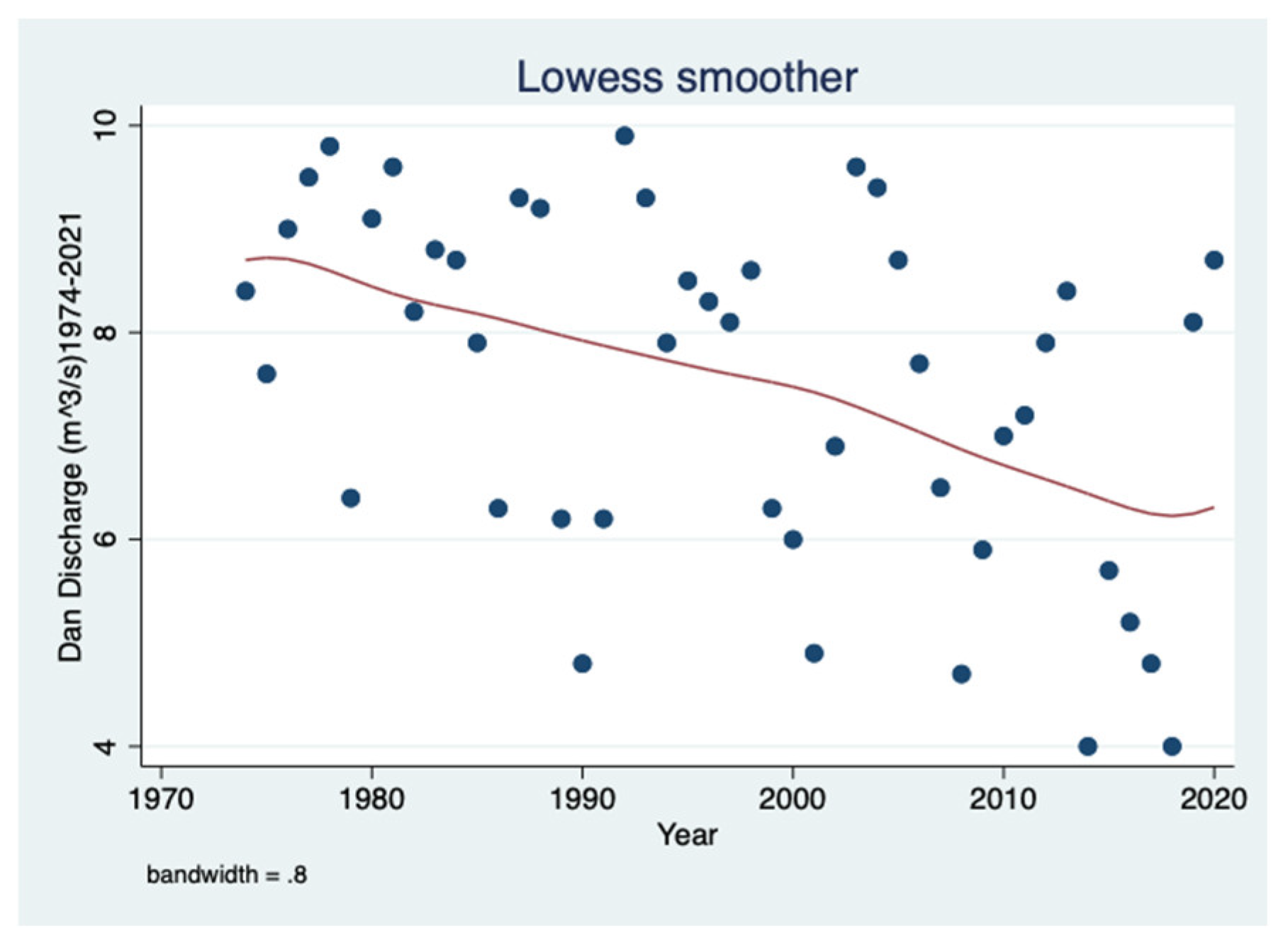

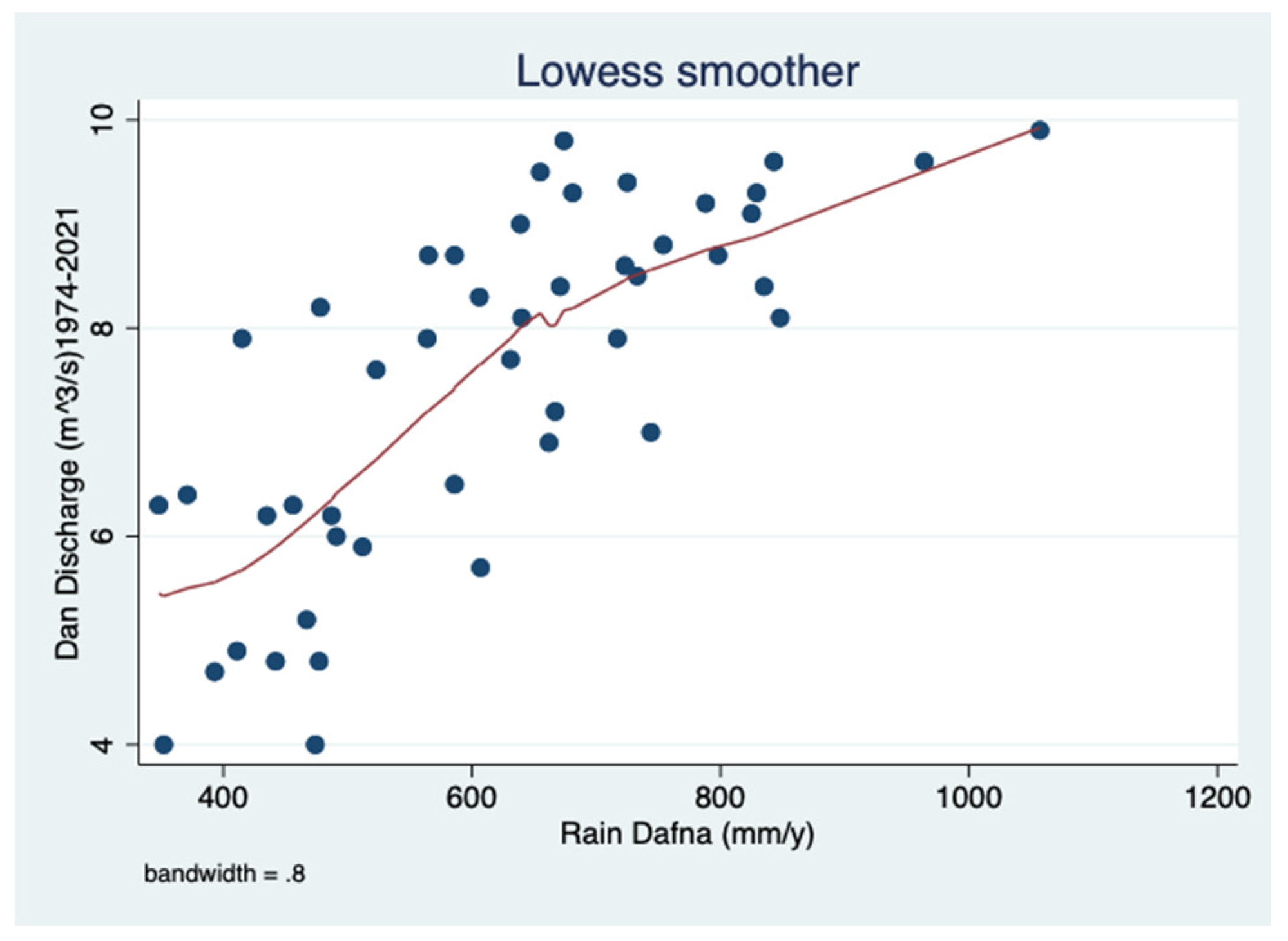
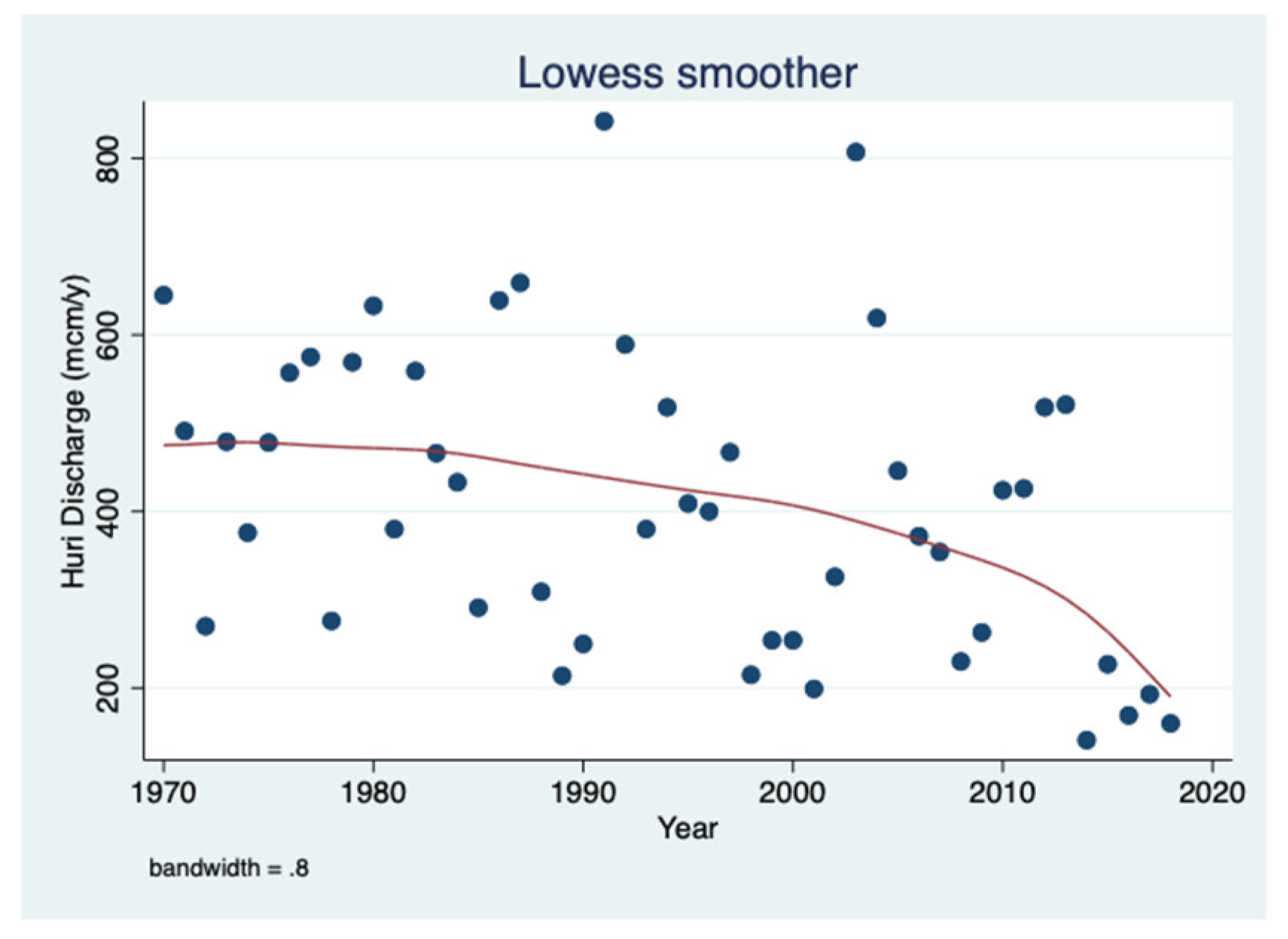
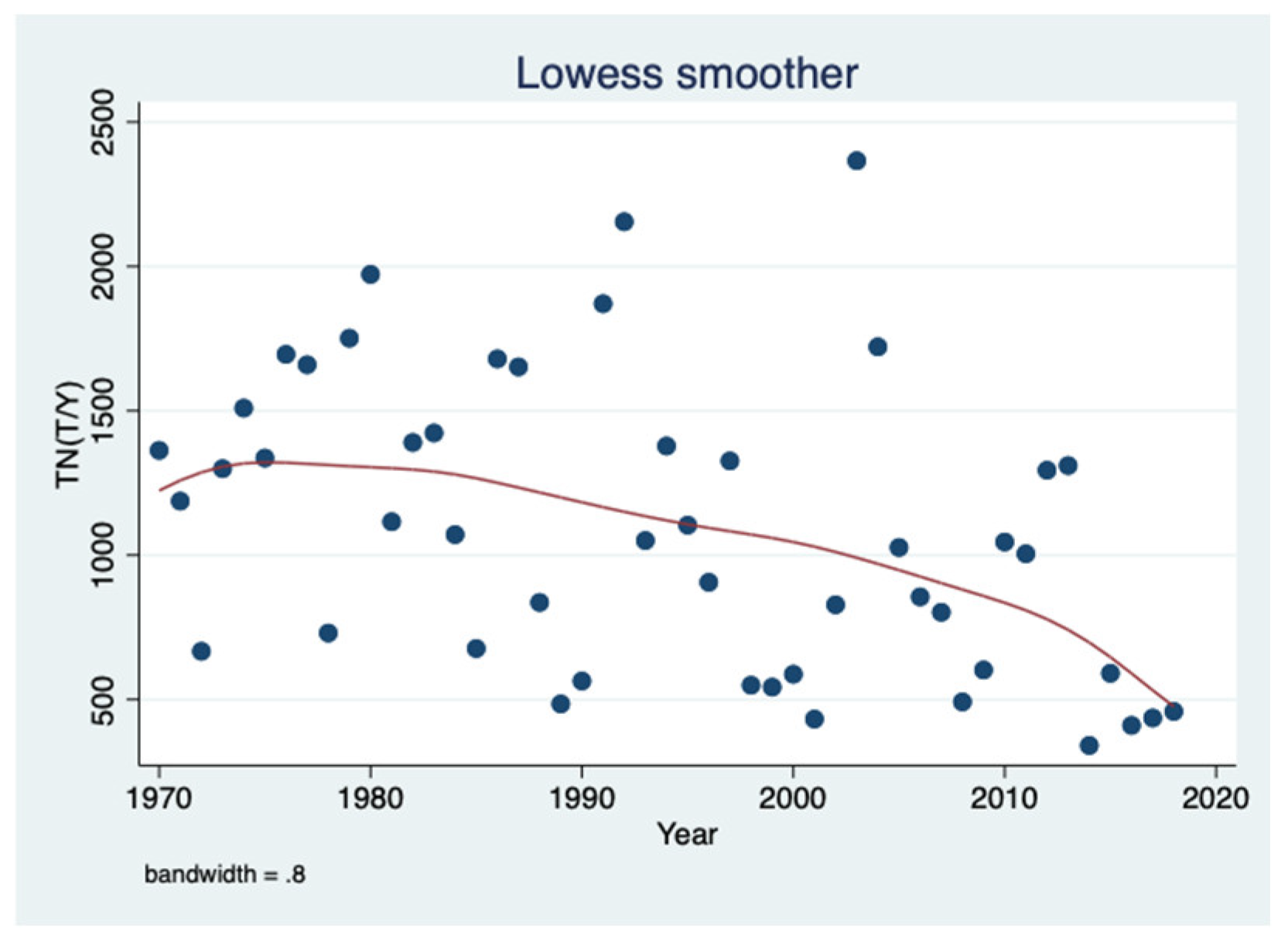
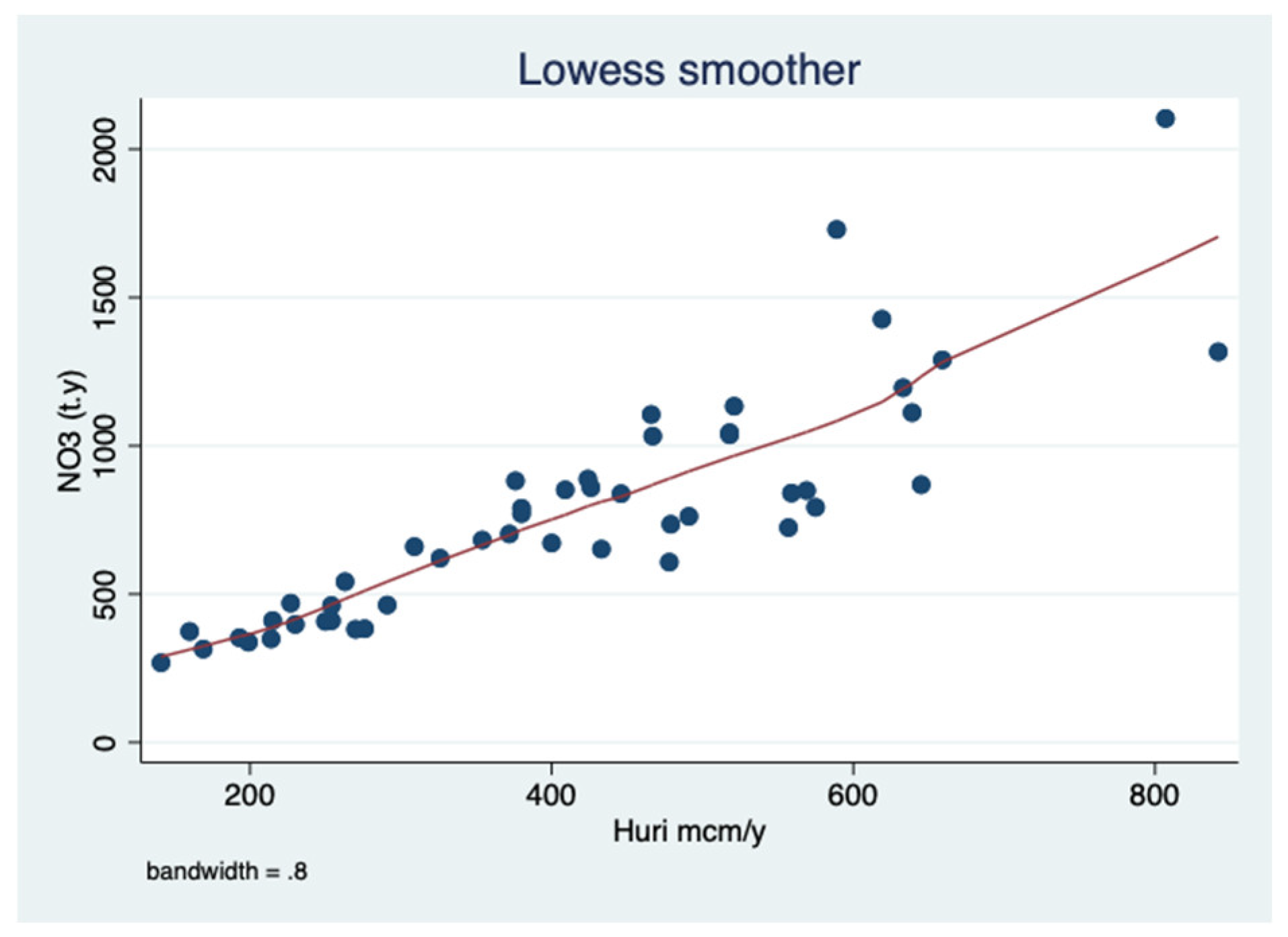
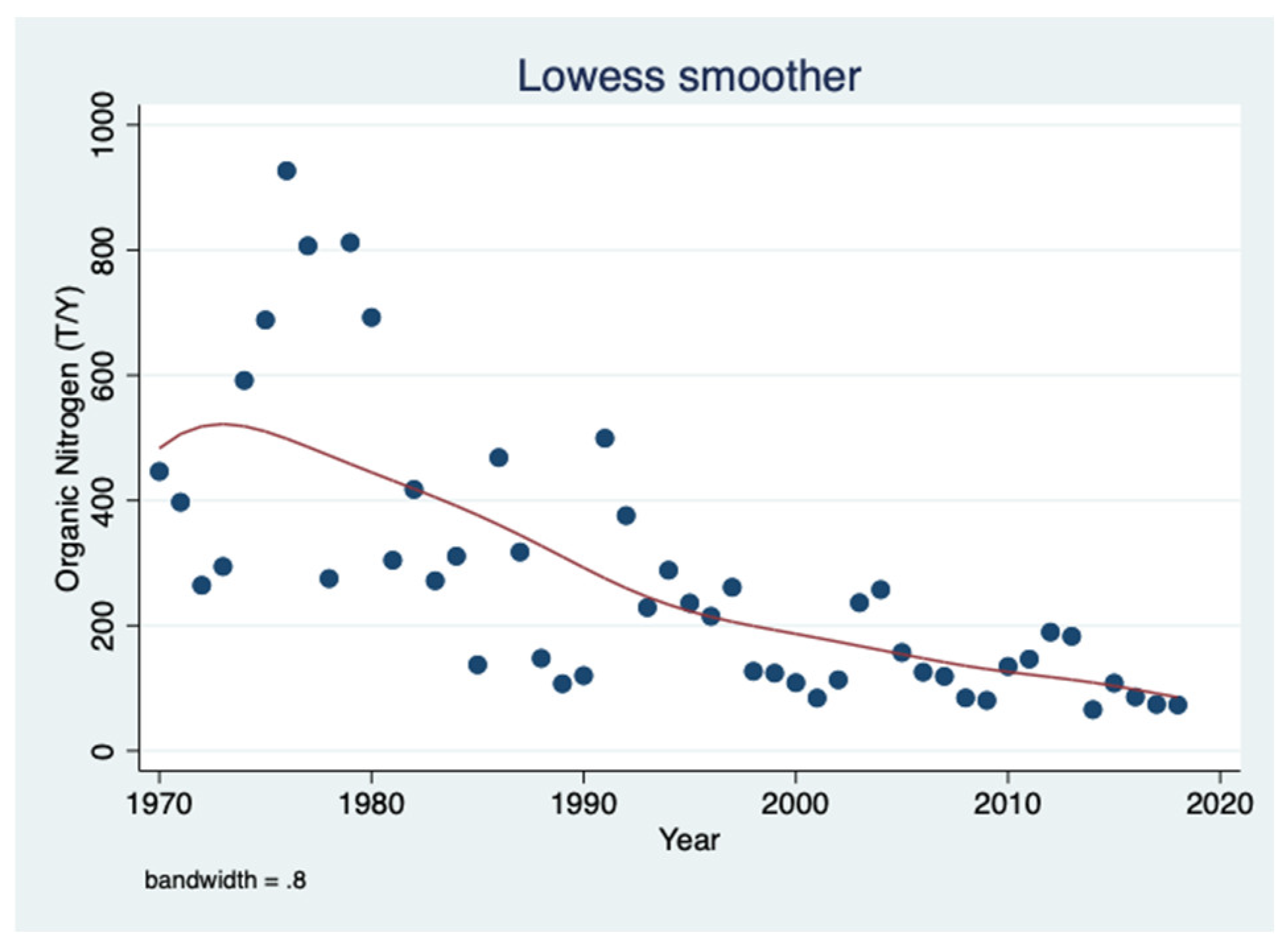

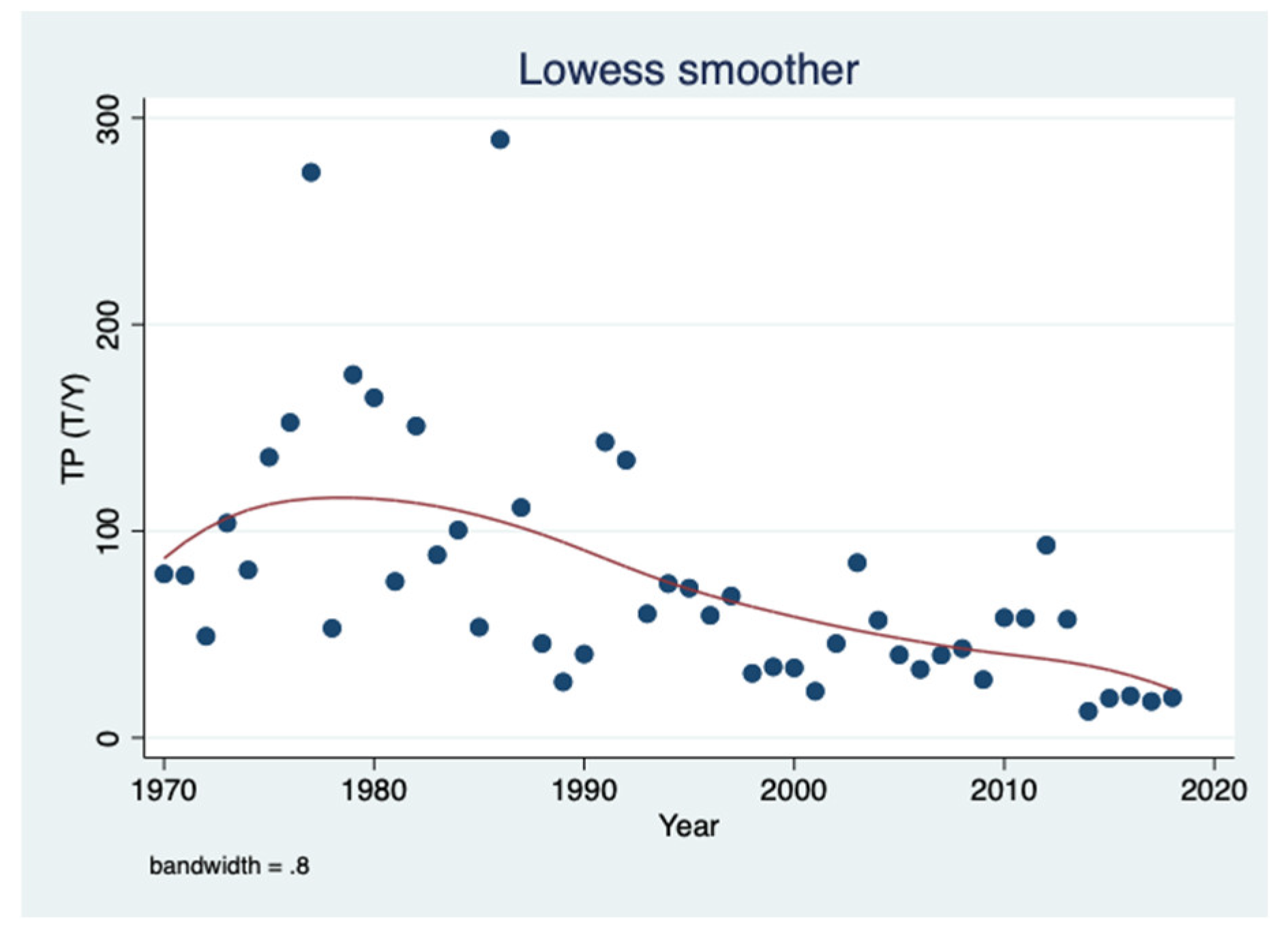
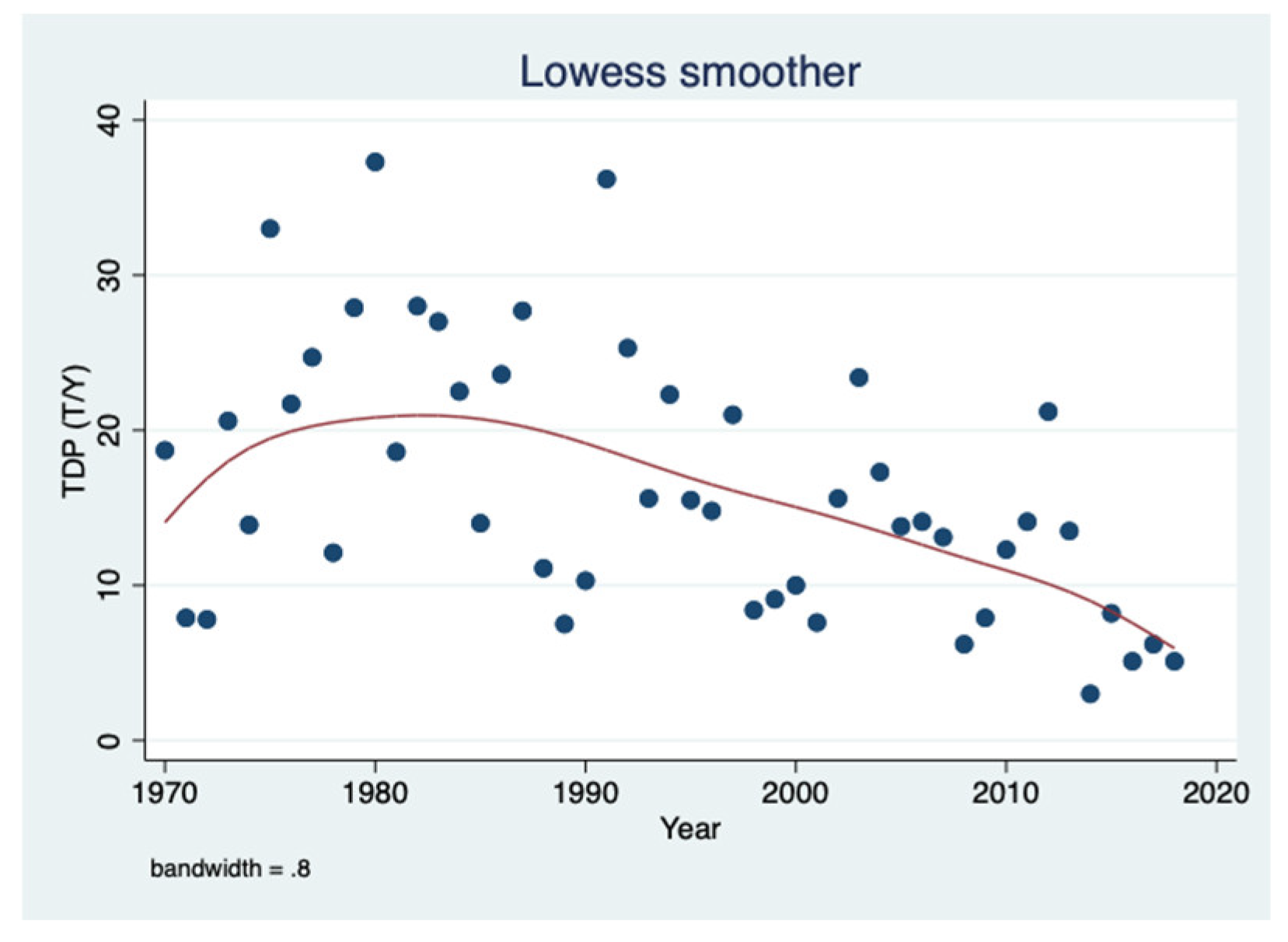
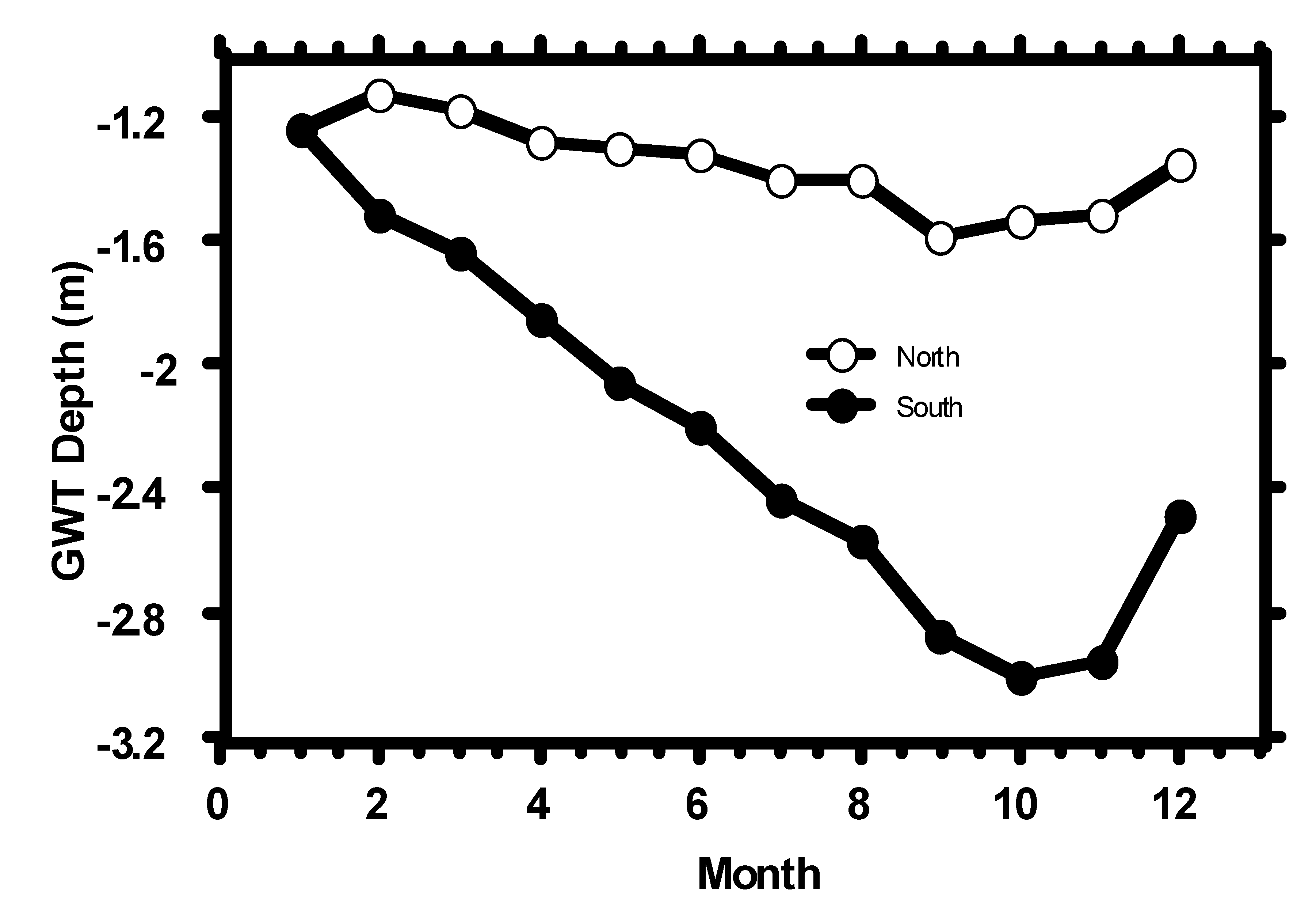
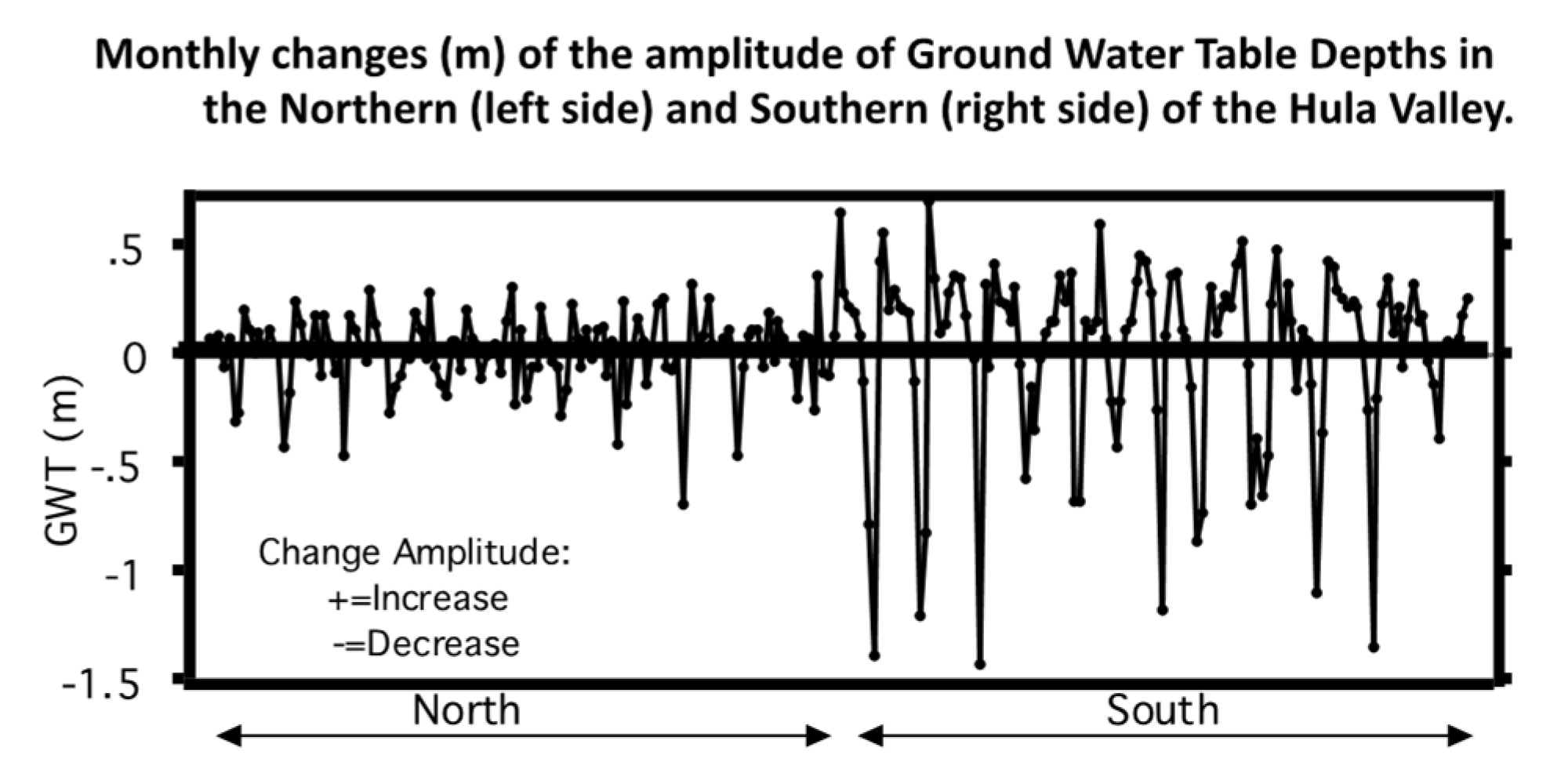
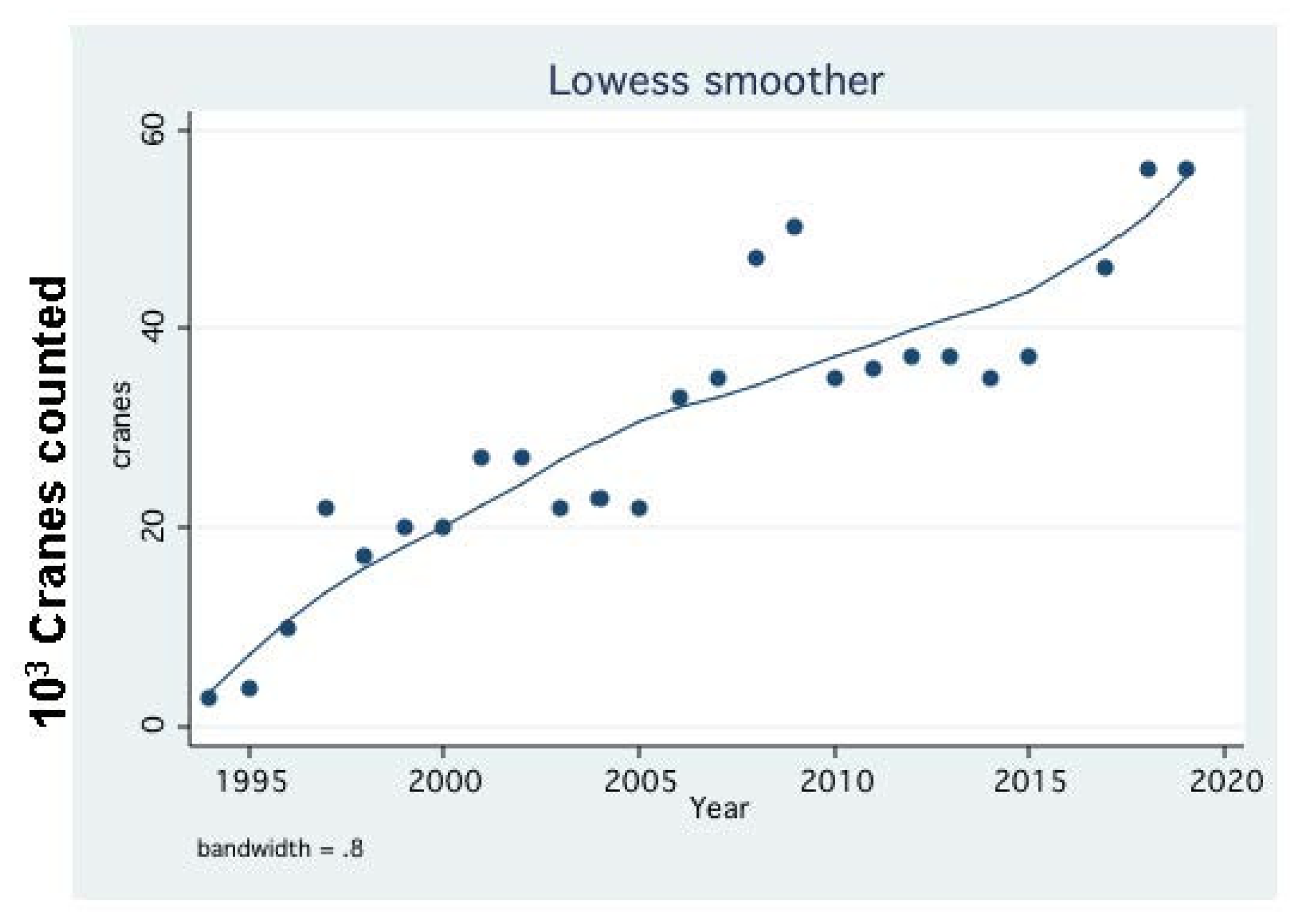
| Used-Cover Type | 1949 | 1958 | 1976 | 1986 | 2010 |
|---|---|---|---|---|---|
| Water | 14 (24%) | 0 | 0 | 1 (2%) | 1 (2%) |
| Swamps | 32 (54%) | 4 (7%) | 4 (7%) | 2 (3%) | 4 (7%) |
| Flooded | 13 (22%) | 0 | 0 | 0 | 0 |
| Field Crops | 0 | 35 (59%) | 46 (79%) | 34 (58%) | 40 (68%) |
| Uncultivated | 0 | 10 (17%) | - | 8 (14%) | 3 (5%) |
| Other | 0 | 5 (8.5%) | 2 (3%) | 6 (10%) | 4 (7%) |
| Orchards | 0 | 0 | 2 (3%) | 5 (8%) | 6 (9%) |
| Fish Ponds | 0 | 5 (8.5%) | 3 (8%) | 3 (5%) | 1 (2%) |
| Total | 59 | 59 | 59 | 59 | 59 |
| Year | Headwaters April | Headwaters Annual | Golan Heights April | Golan Heights Annual | Jordan (Huri) |
|---|---|---|---|---|---|
| 2018 | 7.3 | 2.4 | 0.71 | 0.71 | 8 |
| 2019 | 17.7 | 5.9 | 2.15 | 2.15 | 24 |
| 2020 | 20 | 6.7 | 1.53 | 1.53 | 24 |
| 202 | 13.4 | 4.5 | 0.52 | 0.52 | 15.8 |
| 2022 | 21.4 | 7.1 | 1.6 | 1.6 | 31 |
| 2023 | 12 | 0.81 | 0.81 | 15.5 |
| Month | TP (ppb) |
|---|---|
| 1 | 222 |
| 2 | 258 |
| 3 | 232 |
| 4 | 183 |
| 5 | 222 |
| 6 | 222 |
| 7 | 204 |
| 8 | 317 |
| 9 | 473 |
| 10 | 279 |
| 11 | 325 |
| 12 | 245 |
| Period | Birds | Plants | Fish |
|---|---|---|---|
| Bef-SRD | 2.2 | 0.9 | 2.95 |
| Bef-BDI | 3.6 | 0.15 | 0.49 |
| Aft-SRD | 3.1 | 1.9 | 2.3 |
| Aft-BDI | 0.42 | 0.26 | 0.32 |
Disclaimer/Publisher’s Note: The statements, opinions and data contained in all publications are solely those of the individual author(s) and contributor(s) and not of MDPI and/or the editor(s). MDPI and/or the editor(s) disclaim responsibility for any injury to people or property resulting from any ideas, methods, instructions or products referred to in the content. |
© 2023 by the author. Licensee MDPI, Basel, Switzerland. This article is an open access article distributed under the terms and conditions of the Creative Commons Attribution (CC BY) license (https://creativecommons.org/licenses/by/4.0/).
Share and Cite
Gophen, M. Biodiversity during Pre and Post Hula Valley (Israel) Drainage. Diversity 2023, 15, 758. https://doi.org/10.3390/d15060758
Gophen M. Biodiversity during Pre and Post Hula Valley (Israel) Drainage. Diversity. 2023; 15(6):758. https://doi.org/10.3390/d15060758
Chicago/Turabian StyleGophen, Moshe. 2023. "Biodiversity during Pre and Post Hula Valley (Israel) Drainage" Diversity 15, no. 6: 758. https://doi.org/10.3390/d15060758
APA StyleGophen, M. (2023). Biodiversity during Pre and Post Hula Valley (Israel) Drainage. Diversity, 15(6), 758. https://doi.org/10.3390/d15060758







